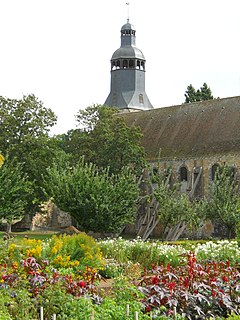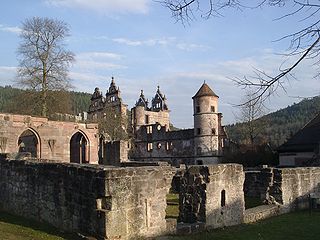The Priory of Saint-Martin-des-Champs was an influential monastery established in what is now the city of Paris, France. Its surviving buildings are considered treasures of Medieval architecture in the city.
Contents

The Priory of Saint-Martin-des-Champs was an influential monastery established in what is now the city of Paris, France. Its surviving buildings are considered treasures of Medieval architecture in the city.


The oldest known structure on the site was a chapel dedicated to St. Martin of Tours, founded during the Merovingian dynasty, which appears in a text of 710. At a date which remains unknown, a community of monks became established there around the chapel. The abbey they founded was pillaged and destroyed by Norman invaders during the late 10th century.
In 1060, King Henry I of France chose to rebuild the complex of the former abbey, intending it then to be a priory of canons regular. At that era, it still remained outside the walls of the city, thus its designation as des champs (in the fields). In 1079 the priory was given to St. Hugh of Cluny and became a Benedictine community, which developed into one of the major houses of the Congregation of Cluny, [1] The priory soon gained major landholdings throughout the region, becoming second in importance only to the Royal Abbey of St-Denis. [2]
The priory church was completed in 1135, having a choir section with a double ambulatory, topped by a simple ribbed arch. The nave was completed during the 13th century, as was the refectory of the priory. The later two are attributed to Pierre de Montreuil. These are the only surviving portions of the monastic complex today. [3]
The priory maintained a major presence in the religious and social life of Paris. It became the site of the last officially sanctioned trial by combat in France in 1386, when both the king and the Parliament of Paris authorized such a contest between the knights Jean de Carrouges and Jacques Le Gris, when the former charged the latter with raping his wife.
Over time, the priory fell subject to the system of commendatory abbots and became the property of a number of titular priors. The famous Cardinal Richelieu can be counted among their number. [4]
The priory was suppressed in 1790 under the new laws of the French Revolution, and the buildings were used as a prison. The monastic walls and dormitories were soon torn down.
The surviving structures of the priory became the home of the Museum of Arts and Crafts, which opened there in 1802. The original Foucault Pendulum was housed there from 1855 until it was irreparably damaged in 2010. [5]

An abbey is a type of monastery used by members of a religious order under the governance of an abbot or abbess. Abbeys provide a complex of buildings and land for religious activities, work, and housing of Christian monks and nuns.

The Basilica of Saint-Denis is a large former medieval abbey church and present cathedral in the city of Saint-Denis, a northern suburb of Paris. The building is of singular importance historically and architecturally as its choir, completed in 1144, is widely considered the first structure to employ all of the elements of Gothic architecture.

The Musée de Cluny, also known as Musée national du Moyen Âge – Thermes et hôtel de Cluny, is a museum of the Middle Ages in Paris, France. It is located in the Latin quarter in the 5th arrondissement of Paris at 6 Place Paul-Painlevé, south of the Boulevard Saint-Germain, between the Boulevard Saint-Michel and the Rue Saint-Jacques.

The Musée des Arts et Métiers is an industrial design museum in Paris that houses the collection of the Conservatoire national des arts et métiers, which was founded in 1794 as a repository for the preservation of scientific instruments and inventions.

The Tironensian Order or the Order of Tiron was a medieval monastic order named after the location of the mother abbey in the woods of Thiron-Gardais in Perche, some 35 miles west of Chartres in France). They were popularly called "Grey Monks" because of their grey robes, which their spiritual cousins, the monks of Savigny, also wore.

Cluny Abbey is a former Benedictine monastery in Cluny, Saône-et-Loire, France. It was dedicated to St Peter.

Flamboyant is a form of late Gothic architecture that developed in Europe in the Late Middle Ages and Renaissance, from around 1375 to the mid-16th century. It is characterized by double curves forming flame-like shapes in the bar-tracery, which give the style its name; by the multiplication of ornamental ribs in the vaults; and by the use of use of the arch in accolade. Ribs in Flamboyant tracery are recognizable by their flowing forms, which are influenced by the earlier curvilinear tracery of the Second Gothic styles. Very tall and narrow pointed arches and gables, particularly double-curved ogee arches, are common in buildings of the Flamboyant style. In most regions of Europe, Late Gothic styles like Flamboyant replaced the earlier Rayonnant style and other early variations.

Saint-Germain-des-Prés is a parish church located in the Saint-Germain-des-Prés quarter of Paris. Founded by Childebert I in the 540s as the Abbaye Sainte-Croix-Saint-Vincent, by the middle of the 8th century it had taken on the name of Saint Germanus, the man appointed bishop of Paris by Childebert and later canonized. Originally located beyond the outskirts of early medieval Paris, it became a rich and important abbey complex and was the burial place of Germanus and of Childebert and other Merovingian kings of Neustria. At that time, the Left Bank was prone to flooding from the Seine, so much of the land could not be built upon and the Abbey stood in the middle of meadows, or prés in French, thereby explaining its appellation, which also serves to distinguish it from the church of Saint-Germain l'Auxerrois near the Louvre. The oldest part of the current church is the prominent western tower, which was built by Abbot Morard around the year 1000.

Hirsau Abbey, formerly known as Hirschau Abbey, was once one of the most important Benedictine abbeys of Germany. It is located in the Hirsau borough of Calw on the northern slopes of the Black Forest mountain range, in the present-day state of Baden-Württemberg. In the 11th and 12th century, the monastery was a centre of the Cluniac Reforms, implemented as "Hirsau Reforms" in the German lands. The complex was devastated during the War of the Palatine Succession in 1692 and not rebuilt.

Carolingian architecture is the style of north European Pre-Romanesque architecture belonging to the period of the Carolingian Renaissance of the late 8th and 9th centuries, when the Carolingian dynasty dominated west European politics. It was a conscious attempt to emulate Roman architecture and to that end it borrowed heavily from Early Christian and Byzantine architecture, though there are nonetheless innovations of its own, resulting in a unique character.

Gorze Abbey was a Benedictine monastery in Gorze in the present arrondissement of Metz, near Metz in Lorraine. It was prominent as the source of a monastic reform movement in the 930s.

Saint-Pierre de Montmartre is one of the oldest surviving churches in Paris but the lesser known of the two main churches in Montmartre, the other being the more famous 19th-century Sacré-Cœur Basilica. Saint-Pierre de Montmartre, built in 1147, was the church of the prestigious Montmartre Abbey.

The Basilica of Saint-Martin d'Ainay is a Romanesque church in Ainay in the Presqu'île district in the historic centre of Lyon, France

French architecture consists of numerous architectural styles that either originated in France or elsewhere and were developed within the territories of France.

French Gothic architecture is an architectural style which emerged in France in 1140, and was dominant until the mid-16th century. The most notable examples are the great Gothic cathedrals of France, including Notre-Dame Cathedral, Reims Cathedral, Chartres Cathedral, and Amiens Cathedral. Its main characteristics were the search for verticality, or height, and the innovative use of the rib vault and flying buttresses and other architectural innovations to distribute the weight of the stone structures to supports on the outside, allowing unprecedented height and volume, The new techniques also permitted the addition of larger windows, including enormous stained glass windows, which filled the cathedrals with light. The French style was widely copied in other parts of northern Europe, particularly Germany and England. It was gradually supplanted as the dominant French style in the mid-16th century by French Renaissance architecture.

Pierre de Montreuil was a French architect. The name formerly given to him by architectural historians, Peter of Montereau, is a misnomer. It was based on his tombstone inscription Musterolo natus, a place name that was mistakenly identified as Montereau rather than Montreuil.

Souvigny Priory, in the commune of Souvigny, Allier, France, in the centre of the old province of the Bourbonnais, was formerly a Cluniac priory, of which the church remains in operation.

The hill of Montmartre became a place of popular pilgrimage after a chapel was erected by the people of Paris, around 475, where Saint Denis, the first bishop of Paris, was martyred. In the ninth century, the chapel, which had become ruined, was rebuilt. Archaeological excavations indicate that many Christians were buried in Montmartre. Their bones were gathered in a quarry on the side of the hill: the Martyrium or champ des morts.

Romanesque architecture appeared in France at the end of the 10th century, with the development of feudal society and the rise and spread of monastic orders, particularly the Benedictines, which built many important abbeys and monasteries in the style. It continued to dominate religious architecture until the appearance of French Gothic architecture in the Ile-de-France between about 1140-1150.

The Church of Saint-Julien-de-Brioude is a Roman Catholic church located in Marolles-en-Brie in the Val-de-Marne department in France. It is dedicated to St. Julian of Brioude and became a Class Historic Monument in 1909.
| Wikimedia Commons has media related to Prieuré Saint-Martin-des-Champs . |